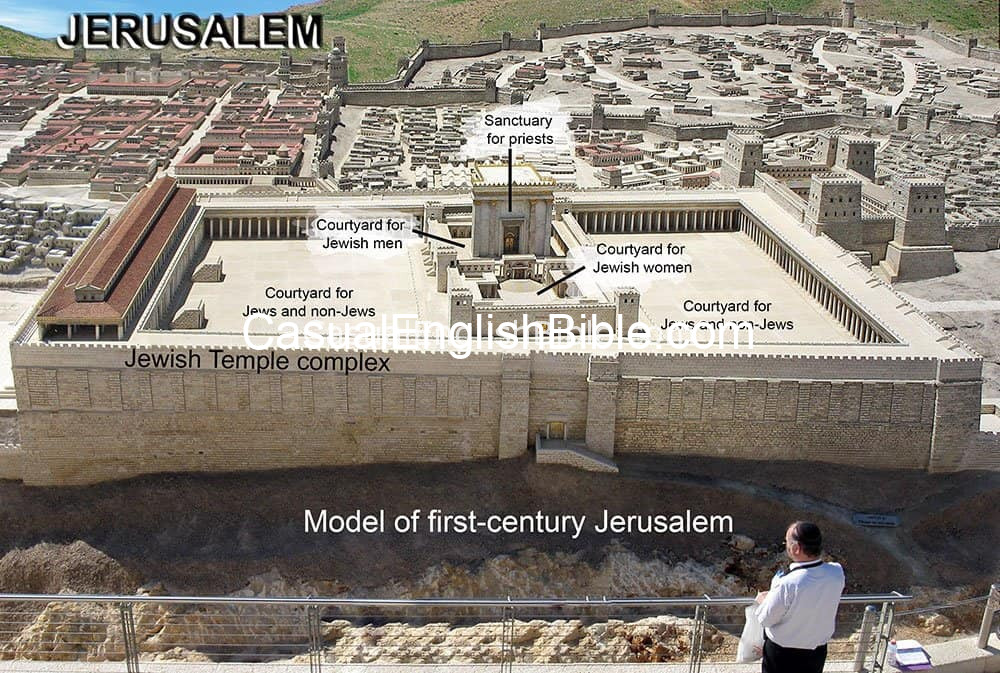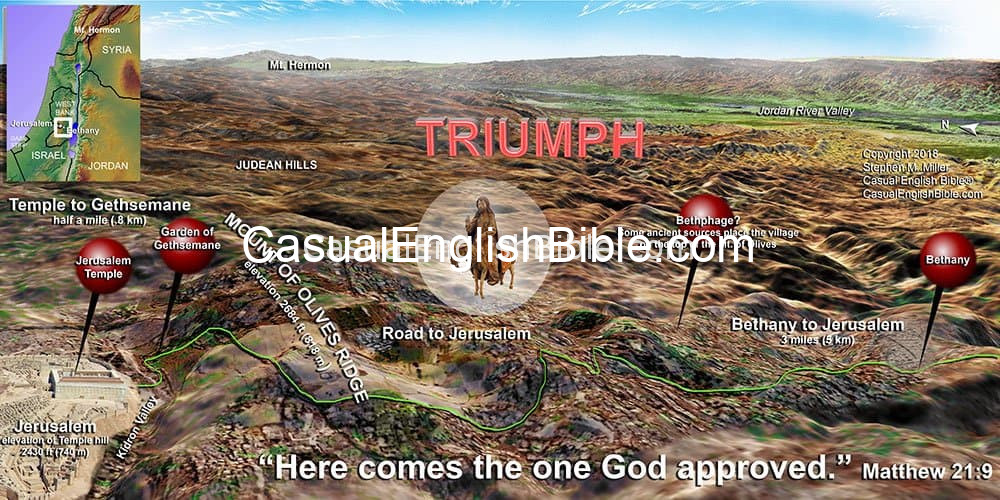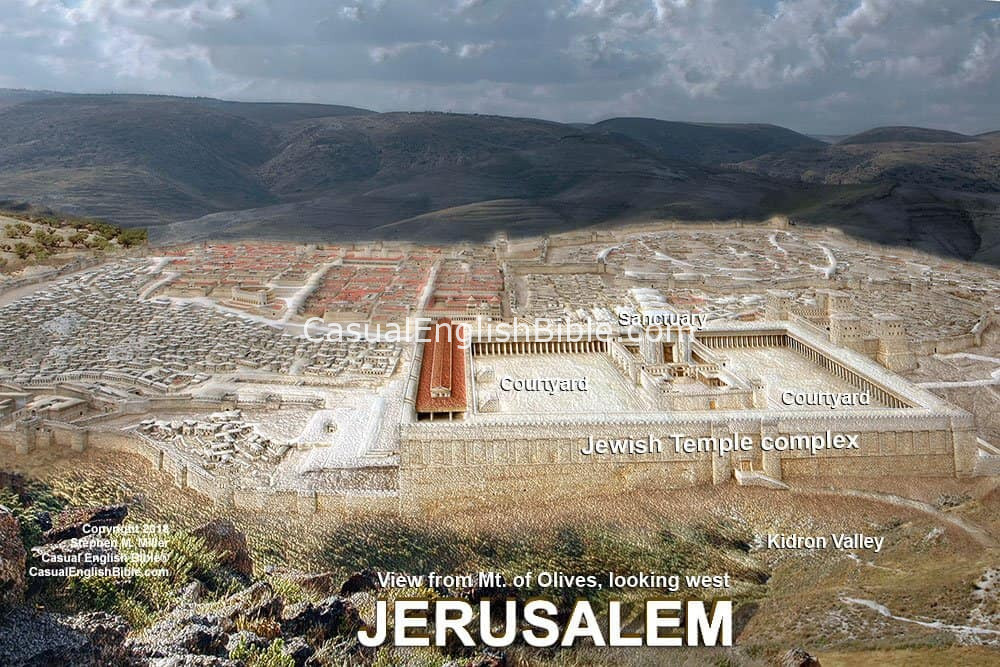Matthew 21
Jesus reaches Jerusalem, where he’ll die
Jesus Enters Jerusalem like a King
1Jesus and his followers reached the outskirts of Jerusalem. When they came to the village of Bethphage [1] on the slopes of the Mount of Olives, Jesus sent two of his disciples ahead. 2Jesus told them, “Go into the next village. As soon as you get there you’ll see a donkey and its colt tied up. Untie them and bring them to me. 3If anyone says anything to you about this, just tell them, ‘The Lord needs them.’ He’ll let you have them right away.”4This happened to fulfill something the prophet predicted, 5“Tell the people of Jerusalem, [2]
‘Look. Here’s your king.
He comes in peace, riding on a donkey.
He comes with a colt too, the foal of a donkey.’ [3] 6So the disciples went ahead and did what Jesus told them to do. 7They brought back the donkey and the colt, then saddled them with their cloaks. Jesus rode them. [4] 8A crowd gathered quickly and spread their cloaks on the road to pave the way for Jesus. Others quickly cut branches from trees and paved the road with them. 9Crowds surrounded Jesus and followed him shouting,
“Save us, [5] Son of David!
Here comes the one God approved. [6]
Hallelujah [7] to high heaven!”
Jesus Cleans House in the Temple
12Jesus went to the Temple. When he got there, he started chasing out everyone who was doing business there, people buying and selling products. He flipped the tables of people who provided currency exchange services, [8] and he knocked over the chairs of merchants selling doves. [9] 13He told them, “It’s written, ‘My house will be a place to pray, but you’re making it a place to steal.’” [10]14Sick people started coming to him at the Temple, people who were blind and crippled. He healed them. 15The top priests and the scholars known as scribes watched Jesus as he did these wonderful things. They stood there listening as even the children started cheering him on, “Save us, Son of David!”
The priests and scholars grew livid. 16They confronted Jesus and said, “Hey, can’t you hear what they’re saying?”
Jesus said, “Sure. Haven’t you read, ‘Even the children and the nursing babies will praise you’?” [11]
17Jesus left Jerusalem and went to Bethany [12] where he spent the night.
That Cursed Fig Tree
18The next morning, as Jesus was walking back to Jerusalem, he got hungry. 19He saw a fig tree by the road and went over to see if there was anything he could eat. He didn’t find anything except leaves. So he told the tree, “I don’t want you ever to produce fruit again!” Instantly, the fig tree withered and died.20When the disciples saw this, it staggered them. They said, “Wow! How could the fig tree wither away that fast?”
21Jesus said, “I’m telling you the truth, if you have faith and you don’t doubt, you’ll not only be able to do what you saw me do to that fig tree but you will be able to say to this mountain, ‘Rise and drop yourself into the sea.’ Then get ready for the splash because what you said is going to happen. 22Whatever you ask for when you pray, you’ve got to believe you’ll get it. And if you do believe, you’ll get it.”
Jewish Leaders Challenge Jesus
23When Jesus got to the Temple, the leading priests and Jewish elders interrupted him when he was teaching. They asked, “Who gave you permission to do this? And what exactly did they tell you you’re supposed to do?”24Jesus said, “I’ll tell you what. I’ll ask you one question. If you answer that question for me, then I’ll tell you where I got the authority to do what I’m doing. 25John baptized people. Where did he get that idea? Did it come from God in heaven, or did it come from humans on earth?”
The Jewish leaders talked among themselves about this. They said, “If we say John got his authority from heaven, he’ll say, ‘Then why didn’t you guys believe him?’ 26And if we say John got his authority from humans, the crowd might turn on us because they think John was a prophet.” 27So they told Jesus, “Sorry, but we don’t know.”
And Jesus said to them, “Well, then, sorry, but I don’t know why I should tell you where I get my authority.”
Parable of Two Sons, One Good and One Good for Nothing
28Jesus said, “What you think about this? A man has two sons. He went to the first one and said, ‘Son, I want you to go out and work in the vineyard today.’29“The son answered, ‘No, I can’t do that today.’ But he later changed his mind and went out and worked in the vineyard.
30“The man went to his second son and said the same thing. The son said, ‘Yes, sir, I’ll do that.’ But he didn’t do that. 31Which of those two sons did what the father wanted?”
The Jewish leaders answered, “The first son.”
Jesus said, “Gentlemen, I’m telling you the truth. Tax collectors and prostitutes will get into the kingdom of God before you do! 32John the Baptist came to show you how you can live your life in a righteous way that would make God happy and proud of you. You didn’t believe him. But tax collectors and prostitutes did. You saw what John did with your own eyes. But you didn’t believe what you saw, and you refused to change your way of thinking.”
Farmers Who Murdered Their Boss’s Son
33Jesus said, “I’ve got another parable for you, so listen up. A landowner planted a vineyard. He put a fence around it. He dug a hole and made a winepress there. He built a watchtower for guarding it. Then he rented sections of the vineyard to sharecroppers and left on a trip. 34When it was time to harvest the grapes, he sent his servants to the tenants to collect his share of the crop.35“The sharecroppers decided not to share. They grabbed the servants and worked them over. They severely beat one of them. They stoned another. They killed a third one.
36“The landowner sent a larger group of servants the next time. But they got the same treatment that the first group got. 37This time, the landowner sent his son. He said, ‘Surely they’ll show some respect to my son.’
38“But that’s not how the sharecroppers reacted. They saw the son and schemed among themselves saying, ‘Hey, this guy is going to inherit the vineyard. How about we kill him and keep the vineyard ourselves?’ 39Sounded like a good idea, so they grabbed him, escorted him off the property, and killed him good and dead.
40“So let me ask you something. When the owner of the vineyard gets back from his trip, what do you think he’ll do to those sharecroppers?”
41The Jewish leaders said, “He’ll give those sorry souls a good reason to be sorry. He’ll kill them good and dead. And he’ll rent the vineyard to sharecroppers who will actually share the crop with him.”
42Jesus said, “Have you ever read this in the Bible?
“‘The stone that the builders said wasn’t good enough to use
has now become the most important stone of all: the cornerstone.
The Lord is the architect.
And what he has produced is a beautiful sight to see.’ [13]
45When the top priests and the Pharisees heard these parables of Jesus, they figured out that he was talking about them. 46They weren’t happy about that. They wanted to arrest him right then. But they were afraid of doing it because they could see that the crowds thought he was a prophet.
Footnotes
It’s uncertain where Bethphage was located, other than it was near Bethany, as one of Jerusalem’s suburbs (Mark 11:1; Luke 19:29). Some ancient sources put it on the crest of the Mount of Olives.
Literally, “the daughter of Zion.” “Zion” was a nickname for the city of Jerusalem.
Zechariah 9:9
Jesus probably did not enter Jerusalem standing up with one foot on each donkey and waving to the crowd. Matthew, unlike the other Gospel versions of the story, seems to suggest that Jesus rode a donkey and the young colt at the same time, or perhaps one after the other. Some scholars say Matthew did this because he misread the prophecy and thought it said the Messiah would ride both animals. So he presented Jesus that way. But the prophecy was written as Hebrew poetry, which uses parallelism the way English poetry uses rhyme. The prophecy literally says the king came “mounted on a donkey, even on a colt, the foal of a donkey” (Zechariah 9:9, New American Standard Bible). Most scholars agree the prophet was using parallelism, referring to just one animal, a young donkey. Some scholars say Matthew correctly reported the scene and Jesus may have ridden the colt, the older donkey walking alongside to calm the young colt “that has never been ridden” (Mark 11:2).
The word is hosanna. It literally means “oh save.” It later evolved into a term used in worship services to express praise, perhaps a bit like the “Hallelujah!” that is sometimes heard in worship services today.
A more traditional translation would be: “Blessed is He who comes in the name of the Lord” (New American Standard Bible). The crowd seems to be quoting Psalm 118:25-26.
See footnote 5 about the word hosanna.
The Temple accepted only certain currency without images of people or animals. That practice eliminated a lot of the Roman currency, which featured the head of emperors. Jews rejected any kind of images of art that depicted people. They did this because of one of the Ten Commandments: “You shall not make for yourself an image in the form of anything in heaven above or on the earth beneath or in the waters below” (Exodus 20:4, New International Version). The apparent intention was to keep the Jews from making any kind of idols. But they extended the command to include currency, art, and Roman army banners with pictures of the emperor.
These merchants were probably providing the service of selling sacrificial doves that people could take into the inner courtyard of the Temple and offer as a sacrifice. It would have been easier to buy the sacrificial animals there, near the Temple, than to bring them from wherever a person lived.
Isaiah 56:7 and Jeremiah 7:11
Jesus is apparently referring to Psalm 8:2.
Bethany was a village on the other side of the ridge of hills called the Mount of Olives, about two miles (3 km) east.
Psalm 118:22-23
Discussion Questions
- 1
Jesus apparently rode a colt—a young donkey—into Jerusalem to fulfill prophecies, according to Matthew’s version of this story (21:4-5). In one prophecy, Isaiah talks about a king coming into Jerusalem (Isaiah 62:11). In another, Zechariah describes the king as humble and riding on a young donkey (Zechariah 9:9). Some Jews apparently associated these prophecies with the Messiah they hoped would come and free them from the Roman Empire. It seems as though Jesus wanted to send the message that he was the Messiah. Do you think he cheated a little in the way he manipulated this event, by riding into Jerusalem in a way that fit the script?
- 2
Luke says Jesus rode a colt, which is a young donkey. Matthew might seem to have him riding a colt and a donkey—two animals at once, or at least with two animals side-by-side. Some Bible experts say Matthew was trying too hard to make the story fit the prophecy, which as far as he was concerned involved two animals. But the prophecy was written as poetry. And one of the traits of Hebrew poetry is parallelism. Instead of rhyming lines as many poets do in English, Hebrew poets repeated ideas. So the prophecy that talks about a donkey and a colt is actually talking about one animal, not two, many Bible experts agree. What do you think of the possibility that Matthew simply misunderstood the prophecy? Or would you argue that Jesus actually rode a young colt that had never been ridden, while its mother walked nearby to keep it calm (an argument some scholars make)?
Here’s how the poetry reads in one Bible version.
“Look, your king is coming to you.
He is righteous and victorious,
yet he is humble, riding on a donkey—
riding on a donkey’s colt” (Zechariah 9:9, New Living Translation). - 3
It seems pretty clear that the people expected Jesus to become the next King of the independent nation of Israel. They cheered him on, likely knowing that he was an ancestor of King David. They cheered, “Here comes the one God approved” (Matthew 21:9). Why do you think Jesus didn’t step off the donkey, quiet the crowd, and say, “People, I’m not that kind of Messiah. Get with the program. I’ll be dead in five days and alive again on Sunday”?
- 4
What’s up with Jesus killing a fig tree? Jesus told the tree, “I don’t want you ever to produce fruit again!” (Matthew 21:19). For heaven’s sake, he seemed to kill it because it didn’t produce figs in the springtime—probably March or early April—when fig trees don’t usually produce fruit until August or September. Scholars debate what to make of this story. Here are a few theories. What do you think about them?
- Symbol of the Temple. The barren fig tree represents the Jewish faith that is based out of the Temple. Its season is over because Jesus has come.
- It’s a story. Winter figs left over from the fall harvest are sometimes available in the spring. There’s no symbolism in the story. Matthew is simply reporting what happened.
- Symbol of the power of faith. Jesus uses the apparent miracle of the dead fig tree to teach his disciples that they can tell a mountain to “Rise and drop yourself into the sea” (Matthew 21:21).
- 5
When Jesus started teaching in the Temple, some of the Jewish leaders asked him for his credentials: “Who gave you permission?” (Matthew 21:23). He wasn’t a fresh face with a hopeful message. He was a threat. Why do you think they saw him as a threat?
- 6
Jesus didn’t seem eager to tell the Jewish leaders that he got his authority from God Almighty. He got out of answering that question by asking them a question they refused to answer: Where did John the Baptist get his authority? They didn’t want to admit that John the Baptist got his authority from God, probably because most of them didn’t believe it. But they didn’t want to call John a fraud because everyone outside their bubble seemed to think he was an authentic prophet (Matthew 21:26). The Jewish leaders didn’t answer Jesus’s question. So he didn’t answer theirs. Why do you think Jesus was reluctant to answer that question?
- 7
In the tale of farmers who murdered their boss’s son (21:33-46), identify the characters you think Jesus might be portraying. Who is the owner of the vineyard? Who are the sharecroppers? The slaves sent as messengers? The son?
- 8
Jesus seems to compare himself to a stone rejected by the builders, yet later chosen as “the cornerstone” (Matthew 21:42; Mark 12:10; Luke 20:17). Who do you think he’s talking about when he says the builders rejected him? And in what way did he or will he become the most important stone in the building?
- 9
What do you think it says about Jesus when the top religion leaders desperately wanted to arrest him but they didn’t because they were afraid of what the crowd would do to them (Matthew 21:46)? This is the home turf for the religion leaders, the courtyard of the only Jewish Temple in the world. But they don’t seem to have the home-court advantage. It seems to belong to Jesus.
- 10
LIFE APPLICATION. When Christians want to justify an angry outburst, they often talk about Jesus getting angry in the Temple and chasing away the merchants who were selling their products in the Temple courtyard (Matthew 21:12-17). What do you think about that? Is it a fair comparison?
- 11
LIFE APPLICATION. Jesus told his disciples they could get whatever they prayed for if they believed. “Whatever you ask for when you pray, you’ve got to believe you’ll get it. And if you do believe, you’ll get it” (Matthew 21:22). With that in mind, should we all start praying for universal healthcare, universal education through college, world peace, and the survival of the planet?








